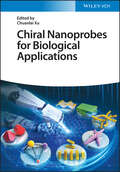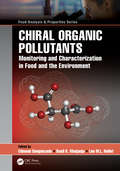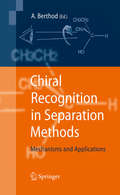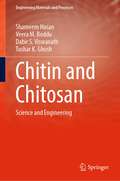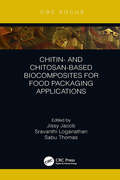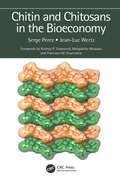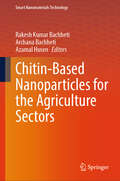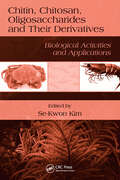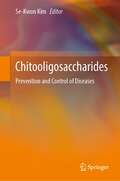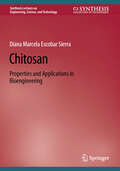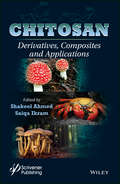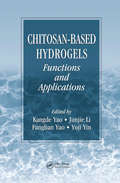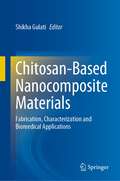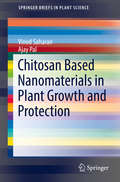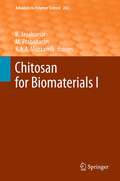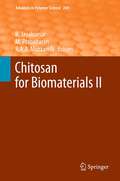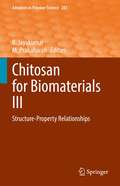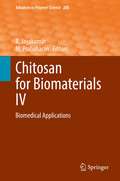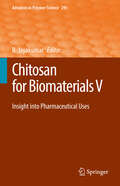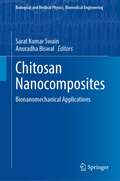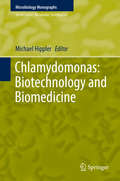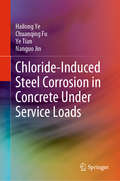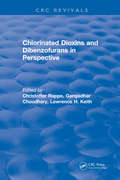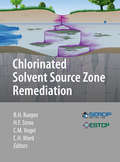- Table View
- List View
Chiral Nanoprobes for Biological Applications
by Chuanlai XuA comprehensive overview exploring the biological applications of chiral nanomaterials Chirality has been the centerpiece of many multidisciplinary fields within the broader umbrella of the sciences. Recent advancements in nanoscience have spurred a growing interest in the dynamic field of chiral nanomaterials. In particular, the recent breakthroughs in chiral nanocrystals have presented an intriguing avenue whose potential application may address some key issues at the heart of nanosciences. While little attention has been focused on the biological implications of such advances, this arena is attracting theoretical and applicative interests. Seeking to provide a thorough introduction to the field as well as fill this gap in scholarship, Chiral Nanoprobes for Biological Applications first provides a comprehensive review of the state-of-the-art development of strong chiroptical nanomaterials, describing how a synthesis and self-assembly approach can enable one to design and create a number of functional chiral nanomaterials. From there, the authors discuss the biological applications of chiral nanomaterials, such as extracellular bioanalysis, intracellular bioanalysis, and chiral recognition, as well as photothermal and photodynamics therapy. In doing so, the book seeks emphasize the potential in multidisciplinary approaches to this up-and-coming field. Chiral Nanoprobes for Biological Applications readers will also find: A particular emphasis on milestones achieved for key chiral nanoprobes research from the last five years A discussion of future research directions A helpful guide for new researchers and established professionals alike Chiral Nanoprobes for Biological Applications is a useful reference for materials scientists, biochemists, protein chemists, stereo chemists, polymer chemists, and physical chemists. It is also a useful tool for libraries.
Chiral Organic Pollutants: Monitoring and Characterization in Food and the Environment (Food Analysis & Properties)
by Edmond Sanganyado Basil K. Munjanja Leo M.L. NolletChiral Organic Pollutants introduces readers to the growing challenges of chirality in synthetic chemicals. In this volume, contributors brilliantly summarize the characteristics of chiral pollutants to provide tools and techniques for effectively assessing their environmental and human health risks. Chapters cover recent research on the physicochemical properties, sources, exposure pathways, environmental fate, toxicity, and enantioselective analysis of chiral organic pollutants. Chiral Organic Pollutants also provides comprehensive discussions on the current trends in the synthesis and legislation of chiral chemicals. Key Features: Includes sampling and analytical methods for the enantioselective analysis of a wide array of chiral organic pollutants in food and the environment Summarizes recent research on the sources, fate, transport, and toxicity of chiral organic pollutants in the environment Critically examines the sources and pathways of chiral organic pollutants such as pesticides, pharmaceuticals, and flame retardants in food Includes a comprehensive discussion on current trends in the enantioselective synthesis and chiral switching of pesticides and pharmaceuticals Provides analysis of current national and international regulations of chiral synthetic chemicals The use of chiral synthetic chemicals such as pesticides, pharmaceuticals, personal care products, and halogenated flame retardants has significantly grown in the past 60 years. Hence, understanding the human and environmental health effects of chiral organic pollutants is crucial in the industry, academia, and policymaking. Chiral Organic Pollutants is an excellent textbook and reference for students, scientists, engineers, and policymakers interested in food quality, environmental pollution, chemical analysis, organic synthesis, and toxicology. Also available in the Food Analysis and Properties Series: Analysis of Nanoplastics and Microplastics in Food, edited by Leo. M.L. Nollet and Khwaja Salahuddin Siddiqi (ISBN: 9781138600188) Proteomics for Food Authentication, edited by Leo M.L. Nollet, and Semih Ötleş (ISBN: 9780367205058) Mass Spectrometry Imaging in Food Analysis, edited by Leo M.L. Nollet (ISBN: 9781138370692) For a complete list of books in this series, please visit our website at: www.crcpress.com/Food-Analysis--Properties/book-series/CRCFOODANPRO
Chiral Recognition in Separation Methods: Mechanisms and Applications
by Alain BerthodThe importance of chiral interactions for both preparative and analytical separations, particularly for pharmaceutical applications, is underlined by numerous publications in this field. Here, for the first time, a team of experienced analysts from industry and academe presents a comprehensive review of the various mechanisms that result in enantiomer separations. A better understanding of these processes is crucial for setting as well as improving chiral separation procedures and also for developing new applications. The coverage in this book includes a range of separation methods, such as gas, liquid, or countercurrent chromatography, and capillary electrophoresis. The special case of chiral ionic liquids is examined in detail. Most modern chiral selectors are discussed, including derivatized polysaccharide- and cyclodextrin-based selectors, along with a newly introduced class of carbohydrates: the cyclofructose selectors. This publication will be required reading not only for research and development departments in the pharmaceutical and cosmetic industries, but also for researchers in toxicology, environmental monitoring, and food research.
Chirality, Magnetism and Magnetoelectricity: Separate Phenomena and Joint Effects in Metamaterial Structures (Topics in Applied Physics #138)
by Eugene KamenetskiiThis book discusses theoretical and experimental advances in metamaterial structures, which are of fundamental importance to many applications in microwave and optical-wave physics and materials science. Metamaterial structures exhibit time-reversal and space-inversion symmetry breaking due to the effects of magnetism and chirality. The book addresses the characteristic properties of various symmetry breaking processes by studying field-matter interaction with use of conventional electromagnetic waves and novel types of engineered fields: twisted-photon fields, toroidal fields, and magnetoelectric fields. In a system with a combined effect of simultaneous breaking of space and time inversion symmetries, one observes the magnetochiral effect. Another similar phenomenon featuring space-time inversion symmetries is related to use of magnetoelectric materials. Cross-coupling of the electric and magnetic components in these material structures, leading to the appearance of new magnetic modes with an electric excitation channel – electromagnons and skyrmions – has resulted in a wealth of strong optical effects such as directional dichroism, magnetochiral dichroism, and rotatory power of the fields. This book contains multifaceted contributions from international leading experts and covers the essential aspects of symmetry-breaking effects, including theory, modeling and design, proven and potential applications in practical devices, fabrication, characterization and measurement. It is ideally suited as an introduction and basic reference work for researchers and graduate students entering this field.
Chitin and Chitosan: Science and Engineering (Engineering Materials and Processes)
by Shameem Hasan Veera M. Boddu Dabir S. Viswanath Tushar K. GhoshThis book reviews work that covers everything from basic chemistry to advanced applications. Chitin and chitosan are used in a plethora of applications from wastewater treatment to prosthetics. After introducing the subject of polysaccharides as a whole, the authors turn to the preparation of chitin and chitosan and the characterization of the latter. The book provides information on chitin chemistry, extraction of chitin, chitosan preparation processes, and the applications of their derivatives in various fields. Among the applications that are included in detail are the adsorption of heavy metals for pollution prevention and clean-up, biosensors, cosmetics, various medical applications from anti-tumor activity to bone tissue engineering, agriculture and food production, and proton exchange membranes for fuel cells.Chitin and Chitosan features:• information on molecular structure, synthesis, properties, and latest research related to chitin and chitosan;• coverage of a wide range of topics from the properties of chitosan to its derivatives and applications;• in-depth information on biomedical applications of chitin and chitosan; and• information that can be applied to other biopolymer processing engineering areas.This book will be of interest to practitioners working in a wide variety of industries for which chitin and chitosan are useful materials, researchers in biosensors and heavy-metal adsorption, and to academic researchers investigating the properties, preparation, and uses of these materials.
Chitin- and Chitosan-Based Biocomposites for Food Packaging Applications
by Sabu Thomas Jissy Jacob Sravanthi LoganathanChitin is one of the most important biopolymers, synthesized by an enormous number of living organisms and is a promising bioactive polymer for food packaging applications due to its functional properties. This book focuses on composition, properties, characterization, and theoretical approach of chitin and chitosan bio-composites. It describes the most recent studies concerning chitin and chitosan-based films and gives an overview about future trends regarding the industrial applications of chitin and chitosan for food packaging purposes. This book is especially useful for researchers in the fields of bionanocomposites, especially those with an interest in packaging applications.
Chitin and Chitosans in the Bioeconomy
by Serge Perez Jean-Luc WertzChitin is the second most abundant natural polymer in the world after cellulose, mainly derived from the food waste of shrimp and crabs. Chitosan is the most important derivative of chitin. Thanks to their biodegradability, non-toxicity, biocompatibility, bioactivity, and versatile chemical and physical properties, chitin and chitosan derivatives are used in a wide variety of applications, including water treatment, cosmetics and toiletries, food and beverages, healthcare/medical, and agrochemicals. Chitin and Chitosans in the Bioeconomy covers all major aspects of chitin and chitosan, including structure, biosynthesis, biodegradation, properties of chitin and derivatives, applications, and market. It offers a special focus on the bioeconomy, which is the renewable segment of the circular economy. Describes the structure, biosynthesis, and biodegradation of chitin and chitosan Covers chitin- and chitosan-based products Details valorization of these materials Presents information on shell biorefineries Chitin and Chitosans in the Bioeconomy serves as a reference for polymer scientists and engineers and is also accessible to economists and advanced students.
Chitin-Based Nanoparticles for the Agriculture Sectors (Smart Nanomaterials Technology)
by Rakesh Kumar Bachheti Archana Bachheti Azamal HusenThis book provides an overview of chitin-based nanoparticles, including their properties, synthesis methods, and characterization techniques. It will also discuss the potential uses of chitin-based nanoparticles in agriculture, such as in crop protection, nutrient delivery, and soil improvement as well as potential areas for future research and development. Overall, the book would present a comprehensive and accessible resource for researchers, agricultural workers, policymakers, and other stakeholders who are interested in learning about the potential applications and benefits of chitin-based nanoparticles in agriculture.
Chitin, Chitosan, Oligosaccharides and Their Derivatives: Biological Activities and Applications
by Se-Kwon KimBiopolymers found in marine animals and plants offer tremendous, largely untapped pharmaceutical potential. Research shows that these biopolymers can be used to combat various infectious as well as inflammatory, oxidative, and carcinogenic factors. Chitin, Chitosan, Oligosaccharides and Their Derivatives: Biological Activities and Applications cove
Chitooligosaccharides: Prevention and Control of Diseases
by Se-Kwon KimThis book outlines the production of chitooligossacharides and their derivatives and discusses their main biological activities, biomedical applications and their role in disease prevention. Chitooligosaccharides are products of chitosan or chitin degradation, prepared by enzymatic or chemical hydrolysis of chitosan, and they consist mainly of N-acetyl glucosamine and glucosamine bonded with a glycosidic bond. Compared to chitin and chitosan, chitooligossacharides offer advantages for large-scale and commercial applications due to their solubility in water and lower molecular weight.Written by leading experts, this book is divided into four parts. The first part provides a general introduction to chitooligossacharides. The second part focuses on the bioproduction of chitooligossacharides through enzymatic synthesis and also covers physical and chemical methods of synthesis. The third part explores the major biological activities of chitooligosaccharides, including antioxidant, antimicrobial, anti-allergic, anti-inflammatory, anti-cancer and neuroprotective activities, and discusses the disease preventing mechanisms of chitooligosaccharides. In this section, readers will also find about the latest in vivo studies which support the use of chitooligosaccharides in the prevention and control of disease. The final part highlights important biomedical applications of chitooligosaccharides, including in tissue engineering, drug delivery and wound healing applications. It also includes the volume editor’s perspective on the health and safety risks of chitooligosaccharides.Given its scope, this book is useful not only for researches in the field but also for students interested in biomaterials, pharmaceuticals, marine biotechnology, nutraceuticals and food science.
Chitosan: Properties and Applications in Bioengineering (Synthesis Lectures on Engineering, Science, and Technology)
by Diana Marcela Escobar SierraChitosan: Properties and Applications in Bioengineering presents a review of chitosan, including information regarding its structure, main properties, available sources, extraction, and processing techniques. It presents the different applications of chitosan as a biomaterial in fields such as medicine and the agricultural, cosmetology, pharmaceutical, and food industries to have readers obtain a more technical vision of the current use of this biopolymer. The book has been researched and written based on the data collected through several years of work in the Biomaterials Research Group, part of the University of Antioquia Bioengineering Program. This concise guide will be valuable for researchers and students in biomaterials, bioengineering, the basic sciences, chemical engineering, and biomedical engineering.
Chitosan: Derivatives, Composites and Applications
by Saiqa Ikram Shakeel AhmedThis book delves deeply in to the preparation, characterization and multiple applications of chitin and chitosan. The 17 chapters written by leading experts is an excellent reference source and state-of-the-art review for researchers and scientists using chitosan or biopolymers in their respective areas. This book is divided into following sections:• Production and derivatives of chitosan• Chitosan in the textile and food industries• Chitosan in biomedical applications• Chitosan in agriculture and water treatment The book is practical as readers will be able to see descriptions of chitosan production methods as well as techniques that can be used to estimate and modify their physical and chemical properties. It provides a full description not only of the traditional and recent developments in the applications of chitosan in the fields of biotechnology, environmental studies, food, medicine, water treatments, drug delivery, but it includes all of the therapeutically usages as well.
Chitosan-Based Hydrogels: Functions and Applications
by Kangde Yao Junjie Li Fanglian Yao Yuji YinDue to their unique properties, chitosan-based materials have emerged as useful resources in a variety of medicines, drug controlled-release carriers, tissue engineering scaffolds, and immobilized enzymes. But many of these materials have yet to reach the commercial market. Therefore, more work must be completed to fill the gap between research and
Chitosan-Based Nanocomposite Materials: Fabrication, Characterization and Biomedical Applications
by Shikha GulatiThis book highlights the state-of-the-art research and discovery in the use of chitosan-based nanocomposites in biomedical applications, including the scope to which these novel materials have been incorporated by the community. It provides an exceptional insight into the strategies for the synthesis and chemical modifications of chitosan, characterization techniques, their use as anticancer agents, antimicrobial, antiviral, and antifungal agents, their role in the biomedical field, and applications in drug delivery, gene therapy, dentistry, orthopedics, etc. This book will also emphasize the challenges with previous signs of progress and way for further research, details relating to the current pioneering technology, and future perspectives with a multidisciplinary approach. Furthermore, it presents up-to-date information on the economics, toxicity, and regulations related to these novel materials.
Chitosan Based Nanomaterials in Plant Growth and Protection (SpringerBriefs in Plant Science)
by Vinod Saharan Ajay PalThis brief describes various methods of chitosan nano-materials synthesis, with detailed discussion of various factors effecting its synthesis process, stability and physicochemical properties. Chitosan is naturally occurring biopolymer derived from chitin. Due to the unique biological properties of chitosan nano-materials such as antimicrobial, plant growth inducer, plant defense modulator, chitosan has gained attention in fields of plant sciences. Book further extended the details of different types of chitosan nano-materials specially for plant applications along with its future prospects in plant protection and growth. Bioactivities of chitosan nano-materials and its mechanism have also been covered. This book aims to widening the understanding of the synthesis, characterization and use of chitosan based nano-materials in plant system.
Chitosan for Biomaterials I (Advances in Polymer Science #243)
by Riccardo A. Muzzarelli M. Prabaharan R. JayakumarPolymeric Nanoparticles of Chitosan Derivatives as DNA and siRNA Carriers, by Y. K. Kim, H. L. Jiang, Y. J. Choi, I. K. Park, M. H. Cho and C. S. Cho.- Chitosan and Its Derivatives for Drug Delivery Perspective, by T. A. Sonia and C. P. Sharma.- Chitosan-based Nanoparticles in Cancer Therapy, by V.-K. Lakshmanan, K. S. Snima, J. D. Bumgardner, S. V. Nair, and R. Jayakumar.- Chitosan and Thiolated Chitosan, by F. Sarti and A. Bernkop-Schnürch.- Chitosan-Based Particulate Systems for Non-Invasive Vaccine Delivery, by S. Şenel.- Multifunctional Chitosan Nanoparticles for Tumor Imaging and Therapy, by J. Y. Yhee, Heebeom Koo, Dong Eun Lee, Kuiwon Choi, Ick Chan Kwon and Kwangmeyung Kim.- Chitosan-Coated Iron Oxide Nanoparticles for Molecular Imaging and Drug Delivery, by H. Arami, Z. Stephen, O. Veiseh and M. Zhang.- Chitosan: Its Applications in Drug-Eluting Devices, by Mei -Chin Chen, Fwu -Long Mi, Zi -Xian Liao and Hsing -Wen Sung.-
Chitosan for Biomaterials II (Advances in Polymer Science #244)
by Rangasamy Jayakumar Riccardo A. Muzzarelli M. PrabaharanPolymeric Bionanocomposites as Promising Materials for Controlled Drug, by M. Prabaharan, R. Jayakumar; Chitosan and Chitosan Derivatives in Drug Delivery and Tissue Engineering, by R. Riva, H. Ragelle, A. des Rieux, N. Duhem, C. Jérôme, and V. Préat; Chitosan: A Promising Biomaterial for Tissue Engineering Scaffolds, by P. K. Dutta, K. Rinki and J. Dutta; Chitosan-Based Biomaterials for Tissue Repair and Regeneration, by X. Liu, L. Ma, Z. Mao and C. Gao; Use of Chitosan as a Bioactive Implant Coating for Bone-Implant Applications, by M. R. Leedy, H. J. Martin, P. A. Norowski, J. A. Jennings, W. O. Haggard, and J.D. Bumgardner; New Techniques for Optimization of Surface Area and Porosity in Nanochitins and Nanochitosans, by R. A. A. Muzzarelli; Production, Properties and Applications of Fungal Cell Wall Polysaccharides: Chitosan and Glucan, by N. New, T. Furuike, and H. Tamura;
Chitosan for Biomaterials III: Structure-Property Relationships (Advances in Polymer Science #287)
by R. Jayakumar M. PrabaharanThis volume deals with chemical modification, structure-property relationship, biological interaction and biomedical applications of chitosan and its chemically modified derivatives. The chapters of this volume provide an overview of the structural comparison of chitosan with other sugar-based biopolymers, a different type of strategy used in chemical modification of chitosan to interact with metal ions and to enhance antimicrobial activity. The chapters further discuss the development of functionalized chitosan hydrogels, films, scaffolds and composites that have the potential to be used in food packaging, enhancing saltiness, biosensors and wound dressing. In addition the fabrication and biological properties of chitosan and its derivatives-based nanofibers are presented. Another important aspect covered in this volume is that of the interaction of chitosan with blood, platelet-rich plasma and stem cells. Finally, this volume presents the current challenges in the development of biomedical products based on chitosan and its derivatives. The volume will be of interest to chemists, material science, biological science and biomaterial scientists can able to understand structure-property relationship, biological interaction and biomedical applications of chitosan and its derivatives.
Chitosan for Biomaterials IV: Biomedical Applications (Advances in Polymer Science #288)
by R. Jayakumar M. PrabaharanThis volume presents the recent developments on the biomedical applications of chitosan and its derivatives. Chitosan exhibits unique properties such as non-toxicity, biodegradability and biocompatibility. Since its chemical structure and properties can be easily modified, it can be an ideal candidate as a biomaterial. Consequently, chitosan and its derivatives are being developed in different forms such as nanoparticles, micelles, nanofibers, hydrogels, films and 3D porous materials for various biomedical applications, ranging from drug and gene delivery to tissue engineering and regenerative medicine. The chapters of this volume focus on the potential use of chitosan and its derivatives as a hemostatic agent, tissue sealants, tissue engineering scaffolds, delivery carriers for bioactive molecules in bone tissue engineering and wound dressings. Some chapter’s deal with recent advancements of chitosan-based biomaterials as a drug, gene and transdermal drug delivery carrier. In addition, the volume focusses on the prospects of chitosan-based systems for the treatment of cancer, eye and other infectious diseases. The volume will be of interest to material scientists, chemists and biotechnologists by providing a better understanding of the physicochemical and biological characteristics of chitosan and its derivatives to develop more appropriate and innovative chitosan-based materials modified for unlimited practical applications in biomedical fields.
Chitosan for Biomaterials V: Insight into Pharmaceutical Uses (Advances in Polymer Science #295)
by R. JayakumarThis volume offers an overview of Chitosan's role in facilitating peptide and biomolecule delivery, microbial resistance in wound care, tissue engineering, hemostasis, and drug delivery. It further delves into the challenges and potential applications of chitosan and its chemically modified derivatives within the pharmaceutical industry, with a particular focus on ocular and oral drug delivery, as well as targeted drug delivery systems. Moreover, this volume sheds light on the prominent use of chitosan and its derivatives, whether in their original forms or as membranes, beads, scaffolds, or films, within the domains of tissue engineering, wound healing, and hemostasis. Collectively, this comprehensive exploration aims to enhance our understanding of recent advancements and innovative chitosan-based systems in pharmaceutical and nutraceutical applications, thereby illuminating the myriad possibilities that lie ahead.
Chitosan Nanocomposites: Bionanomechanical Applications (Biological and Medical Physics, Biomedical Engineering)
by Sarat Kumar Swain Anuradha BiswalThe book presents chitosan and chitosan-based nanocomposites and their extensive applications in medical science. Utilization of chitosan nanostructured composites in different biomedical applications is highlighted. The book is suitable to be used as reference/textbook for studying the biological aspects of chitosan hybrid materials and their efficacy in different therapeutic applications. The important features of the book are summarized as follows:Chitosan as an overviewKey biological aspects of chitosan-based nanocompositesSynthetic techniques for fabrication of chitosan nanocomposites for biomedical applicationsDesigning of chitosan-based smart materials for release of therapeuticsFabrication of nanostructured chitosan-based devices for diagnosis and sensing applicationsChitosan nanocomposites for regenerative applicationsMedicinal and therapeutic efficacy of chitosan-based hybrid materials.
Chlamydomonas: Biotechnology and Biomedicine (Microbiology Monographs #31)
by Michael HipplerThis Microbiology Monographs volume covers the current and most recent advances in genomics and genetics, biochemistry, physiology, and molecular biology of C. reinhardtii. Expert international scientists contribute with reviews on the genome, post-genomic techniques, the genetic toolbox development as well as new insights in regulation of photosynthesis and acclimation strategies towards environmental stresses and other structural and genetic aspects, including applicable aspects in biotechnology and biomedicine. Advancement in Chlamydomonas biology allowed new understandings in biotechnological and biomedical related aspects.
Chloride-Induced Steel Corrosion in Concrete Under Service Loads
by Ye Tian Hailong Ye Chuanqing Fu Nanguo JinThis book summarizes the latest advances in understanding chloride ingress and steel corrosion in concrete under service loads. Unlike the existing literature, it focuses specifically on the effect of service loads on chloride-induced durability issues in reinforced concrete structures. It discusses how service loads affect the moisture and chloride penetration rate, corrosion kinetics and rust distribution, as well as the structural performance of concrete components (e.g. beams and columns) in a systematic and hierarchical way. Given its scope, the book is chiefly intended for researchers and industry practitioners in structural engineering, particularly those whose work involves the durability design of concrete structures.
Chlorinated Dioxins and Dibenzofurans in Perspective
by Christoffer RappeThis volume was developed from the proceedings of a symposium held in Miami Beach, at the 189th National Meeting of the American Chemical Society.It is the result of the combined efforts of many experts whose efforts have advanced our knowledge of the production, analysis, distribution, effects and control of chlorinated dioxins, dibenzofurans and related compounds.This is the third in a series of publications originating from current technology presented at national meetings of the American Chemical Society. Using this forum as a catalyst, researchers from all over the world came together to present and discuss their data and plan future work in this rapidly developing and sometimes highly emotional technical area.
Chlorinated Solvent Source Zone Remediation (SERDP ESTCP Environmental Remediation Technology #7)
by C. Herb Ward Hans F. Stroo Bernard H. Kueper Catherine M. VogelThe purpose of this book is to help engineers and scientists better understand dense nonaqueous phase liquid (DNAPL) contamination of groundwater and the methods and technology used for characterization and remediation. Remediation of DNAPL source zones is very difficult and controversial and must be based on state-of-the-art knowledge of the behavior (transport and fate) of nonaqueous phase liquids in the subsurface and site specific geology, chemistry and hydrology. This volume is focused on the characterization and remediation of nonaqueous phase chlorinated solvents and it is hoped that mid-level engineers and scientists will find this book helpful in understanding the current state-of-practice of DNAPL source zone management and remediation.
